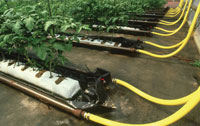Ask people the question ‘what do plants need to grow?’ and their replies will almost certainly include soil and water. Yet hydroponics – the technology of growing plants without soil – is widely used around the globe for growing food crops. While the term often conjures up images associated with the illegal growing of certain plant species, the role of hydroponics in food production is less well known despite the fact that many fruits and vegetables on display in supermarkets are grown hydroponically. And as we move into an era in which food supply will become a key global challenge, hydroponic production has the potential to play a bigger role in meeting the increasing demand for food.
Hydroponics is not 'new' technology and can trace its history back thousands of years to the legendary gardens of the Babylonians and Aztecs. However, its commercial usage has increased dramatically in the latter part of the 20th century. More recently, NASA has investigated hydroponics as a means of producing the crops required to meet the life support needs of astronauts in long-term space exploration missions through a ‘Biomass Production Facility’ and scientists have even exploited hydroponics in nanotechnology by 'growing' metal nanoparticles in living plants!
Although hydroponics is defined as growing plants without soil, in reality many systems use an inert, sterilised material or substrate to support the plants and the inorganic ions and minerals essential for healthy plant growth and development are provided by nutrient solutions. However, some systems, such as the nutrient film technique (NFT), which is widely used commercially in the UK, only use supporting media during propagation, and so are truly hydroponic.

The most popular crops grown hydroponically are tomatoes, cucumbers and sweet peppers; others include melons, lettuce, strawberries, herbs, aubergine, chillies, and ornamental plants and flowers. In 2009, the UK produced 87,000t of tomatoes most using the NFT technique in greenhouses covering ca. 200 ha of land and employing almost 2500 people. Approximately 3520 ha of land would be required to cultivate the equivalent quantity in soil.
Despite the advantages of hydroponic horticulture, however, the industry faces a number of economic and physical challenges. The past decade has seen a 10-fold drop in tomato production in the UK, with only 20% of the tomatoes sold in the UK today being grown domestically. A staggering 400,000t of fresh tomatoes are imported from countries such as Spain, Canary Islands, Holland, Morocco, Poland, Italy, Belgium and Israel. In the early 1990s, Spanish growers adopted 800 ha of land for hydroponic production and a decade later, this had risen to 4000 ha. The main reason is the cost of production; the Mediterranean climate is milder, especially in winter, so less heating is required than in the UK, where expensive climate control and supplementary lighting is needed.
UK hydroponic growers therefore face the challenge of reducing energy consumption and improving efficiency. There is also a significant push to reduce waste. In many early systems, the waste mineral nutrient solutions were simply discarded. However, this is no longer acceptable and, given the potential for future shortages of supply of certain minerals, particularly phosphate (C&I, 2011, 2, 21), nowadays there is greater emphasis on the use of re-circulating systems with automated nutrient dosing. Another issue for media-based hydroponic systems is the disposal and recycling of the waste substrate, particularly rockwool.
In contrast to the commercial situation, over the past decade the UK has seen a massive increase in DIY hydroponics, which has recently increased by an estimated 20% despite the economic downturn. DIY hydroponics has emerged as a specialist subset of the ‘grow your own’ market, fuelled by an increasing awareness of food production and the perceived health risks of pesticides and herbicides. A sleek, clean, compact hydroponic system on a balcony or windowsill is often the option of choice for use in suburban conservatories or smart highrise apartments. Several companies produce and supply equipment and consumables and there is a staggering array of nutrients available, including conventional two-pack nutrients available for hard and soft water in grow and bloom formulations, biological nutrients and specialist additives.
Aquaculture in Sheffield is one of the UK’s largest manufacturers of liquid nutrients for hydroponics and is helping to support research at Sheffield Hallam University developing new and improved nutrient systems for both commercial and hobby applications. For the hobby market, for example, there is increasing demand for easy to use ‘convenience’ nutrients combining the elements contained in traditional A and B nutrients in a single one-part solution. Simply mixing A and B nutrients in a single formulation results in the formation of calcium-containing precipitates, which can be prevented by adding chelating agents such as ethylene diaminetetraacetic acid (EDTA). However, the quantities of chelating agents required can be harmful to the plants and significantly increases the cost.
Aquaculture has therefore developed a solution containing a 'natural' chelating agent humate, a naturally occurring organic material formed through the degradation of plant and animal matter. But while humate prevents precipitate formation in the short term, it compromises the product shelf life, reducing it to two years compared with five years for conventional nutrients. Also, humate, which is suspended in the nutrient solution, is difficult to handle and tends to settle-out during production, leading to blockages in the manufacturing plant. As with industrial-scale operations, the rising cost and supply of raw materials and transport is an area of concern and the team is looking at ways of controlling and reducing these, together with ways of recycling nutrient waste.
Other applications for hydroponics include the production of fodder, important in the diet of domesticated livestock. Semi-automated fodder production systems allow the rapid growth of fodder in the form of sprouted grains of barley, sunflower and lupin within a controlled environment. The systems spray a fine mist of water onto trays of seeds held at a temperature of 19-21°C with an average relative humidity of 60-70%. As the seeds germinate, a mat of sprouting grains forms which is known as a ‘biscuit’. The biscuits are harvested during the third phase of germination just six days after sowing.
Aquaculture has been investigating the effect of different forms of nutrient on the growth of fodder in a hydroponic production system with the aims of speeding-up the rate of production and increasing its nutritional content. Initial studies have focused on the germination rate and mass of fodder produced and found an average increase of 10%.
Another potential application for semi-automated hydroponic systems such as these is production of biofuel crops. As competition for land between crops for food and fuel increases, with the assistance of genetic engineering, these systems could be used to produce lignocellulosic biomass, which in turn can be digested and fermented to produce ethanol, thus easing the burden on farmland.
Future outlook
The world’s population will grow to an estimated 8bn people by 2025 and 9bn by 2050. To satisfy the anticipated demand, 50% more food will need to be produced on the same land area. From a commercial perspective, hydroponic technologies have the potential to help meet this increased demand, particularly in those regions of the world that have limited arable land such as Africa, Asia and parts of Australasia and the US.
Future developments in hydroponic techniques are likely to concentrate on energy and water usage; recirculating systems can be very water-efficient, re-using up to 90% of the water. Nutrient management in agricultural production is increasingly important and is more effective in hydroponic than soil-based production, so preserving scarce mineral resources – particularly phosphate. Accessible sources of phosphate are close to exhaustion, with an estimated 100 years of supply remaining, so hydroponics could play a role in preventing the overuse of phosphate and the recovery and recycling of unused phosphate nutrients.
For the home/DIY market, hydroponics is likely to remain a niche part of the broader gardening and 'grow your own' market. Nonetheless, there are opportunities for business growth, although the longer-term prospects are inextricably linked to the price and availability of the minerals used in the nutrient solutions.
Callie Seaman is a research scientist/ manufacturing manager at Aquaculture in Sheffield, UK, and a part-time PhD student at Sheffield Hallam University. Neil Bricklebank is a chemistry lecturer at Sheffield Hallam University.
Hydroponic techniques
The term hydroponics incorporates a number of related techniques that can be split into two broad categories.
Media-based systems use materials such as rockwool, coir fibre, perlite or clay pebbles to support the growing plants. The nutrient solutions are delivered by dripfeeding or by ebb and flow, in which the plants are flooded with a nutrient solution at pre-determined intervals, pulling oxygen from the atmosphere to the root zone. The solution is then drained back into a header tank and re-circulated.
Non-media techniques include the Nutrient Film Technique (NFT) in which plants are grown in an 'open root system' with re-circulating nutrient solutions. In so-called deep water culture, the roots are permanently submerged in a nutrient solution which is aerated to maintain adequate levels of dissolved oxygen and prevent stagnation. This method is more popular with the DIY market due to its ease of use. In aeroponics the roots are suspended in an environmental chamber and sprayed with nutrient solution.
The common feature of all hydroponic systems is the requirement for aqueous nutrient solutions, which provide the plants with all the elements they require. The macro-elements, N, P, K, Ca, Mg and S, are provided in high concentrations, usually as mineral salts – normally nitrates, sulfates, phosphates. The microelements, Fe, Cu, Zn, B, Mo and Mn, are typically supplied as complexes chelated with EDTA at much lower concentrations. Traditionally, nutrients are produced as two stock solutions, known in the industry as 'A' and 'B'. The 'A' solution contains the calcium and magnesium salts and the 'B' solution the phosphate, sulfate, potassium and microelements. This avoids formation of unwanted calcium phosphate and sulfate precipitates that reduce the bioavailability of these elements and block the physical infrastructure. The nature of the nutrient solution is tailored for the specific application, such as species of plant or local conditions such as water hardness.




